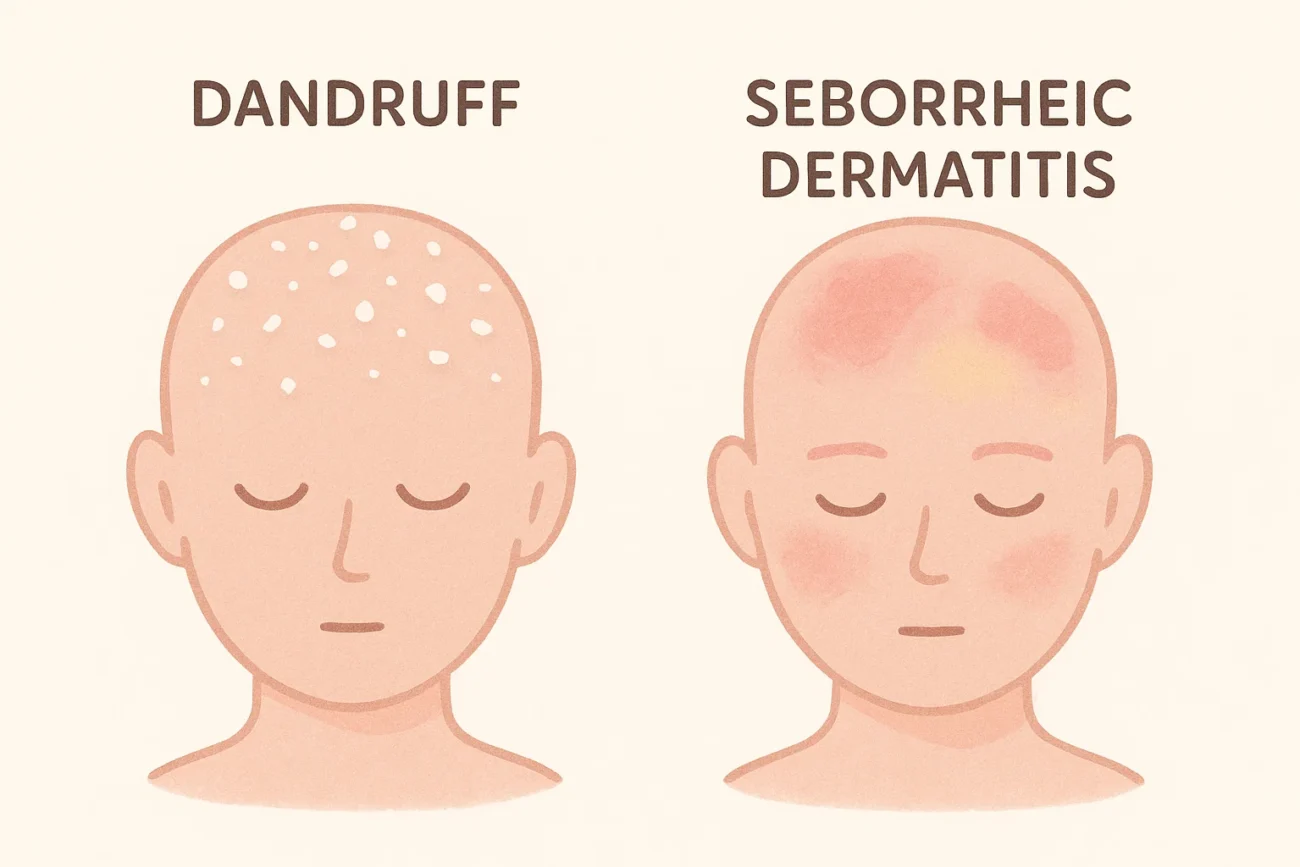A flaky scalp can be frustrating—and confusing. Many people assume that all scalp flakes are just dandruff, but that’s not always the case. In fact, a more persistent, itchy, or inflamed scalp could be a sign of seborrheic dermatitis. While they share some symptoms, seborrheic dermatitis vs dandruff are two distinct conditions that require different approaches to care.
At Dr Ujjvala Skin Clinic, we often see patients unsure of what they’re dealing with. This article breaks down the differences between seborrheic dermatitis vs dandruff, their causes, and effective treatment options to help you take the right steps toward a healthier scalp.
Understanding Dandruff
Dandruff is a common scalp condition that causes dry, white flakes of dead skin. It’s usually not serious and doesn’t cause inflammation or long-term scalp damage. Often, it’s simply the result of an overgrowth of a yeast-like fungus called Malassezia, which thrives in oily areas of the scalp.
Triggers for dandruff can include:
- Stress
- Hormonal changes
- Weather changes (especially cold, dry climates)
- Infrequent hair washing or using irritating hair products
Dandruff treatment typically involves using over-the-counter shampoos containing ingredients like zinc pyrithione, ketoconazole, or selenium sulfide. With regular use, symptoms usually improve within a few weeks.
What is Seborrheic Dermatitis?
Seborrheic dermatitis is a chronic inflammatory skin condition that affects areas rich in oil glands—like the scalp, face, chest, and back. On the scalp, it causes greasy, yellowish flakes, redness, and itching.
Unlike dandruff, seborrheic dermatitis can spread beyond the scalp to areas like the eyebrows, sides of the nose, and behind the ears. It can also occur in infants, where it’s known as cradle cap.
Seborrheic dermatitis is thought to be caused by a combination of an overactive immune response, skin oil (sebum), and the presence of Malassezia. Environmental and internal triggers such as stress, fatigue, cold weather, or underlying conditions like Parkinson’s disease or HIV can make symptoms worse.
Treatment Options
-
Dandruff Treatment
For most people, dandruff treatment starts with switching to an anti-fungal or medicated shampoo. Ingredients to look for include:
- Zinc pyrithione
- Ketoconazole
- Salicylic acid
- Coal tar
Use these shampoos 2–3 times a week, letting the lather sit for a few minutes before rinsing. Avoid harsh hair products and keep the scalp clean to prevent buildup.
-
Seborrheic Dermatitis Treatment
Managing seborrheic dermatitis may require a more comprehensive approach. Effective seborrheic dermatitis treatment includes:
- Prescription shampoos with ketoconazole or ciclopirox
- Topical corticosteroids to reduce inflammation (short-term use only)
- Antifungal creams for affected areas beyond the scalp
- Gentle skincare routine with fragrance-free products
- Phototherapy in severe cases
If over-the-counter solutions don’t work or your symptoms spread beyond the scalp, seek professional help. Our team at Dr Ujjvala Skin Clinic offers tailored seborrheic dermatitis treatment plans for long-term relief.
When to See a Dermatologist
While occasional flaking is normal, you should consult a dermatologist if you experience:
- Red, itchy patches that spread beyond the scalp
- Persistent symptoms despite over-the-counter products
- Painful or oozing skin
- Significant hair loss
Understanding whether you’re dealing with seborrheic dermatitis vs dandruff can make a major difference in your treatment plan. At Dr Ujjvala Skin Clinic, we assess your condition and suggest the most suitable care based on your skin type and lifestyle.
FAQs
-
Is seborrheic dermatitis contagious?
No, seborrheic dermatitis is not contagious. It is a skin condition influenced by factors like genetics, immune response, and environmental triggers.
-
Can I have both dandruff and seborrheic dermatitis?
Yes, it’s possible. Many people begin with mild dandruff and develop seborrheic dermatitis if the condition worsens or goes untreated.
-
How long does it take for treatment to work?
With consistent use, dandruff treatment can show results in a few weeks. Seborrheic dermatitis treatment may take longer and often requires ongoing management to prevent flare-ups.
-
What should I avoid during a seborrheic dermatitis flare-up?
Avoid harsh shampoos, scented products, and excessive scratching. Stick to dermatologist-recommended products during flare-ups.
-
Can diet affect these conditions?
While not a direct cause, high-sugar and high-fat diets may trigger inflammation in some people. A balanced diet can support skin health overall.
Why Choose Us?
Choose us as your trusted dermatology services for exceptional skin, hair, and nail care. We prioritize your skin health with a patient-centered approach, offering personalized treatments for a wide range of dermatological concerns. Our commitment to accessibility, responsiveness, and compassionate care ensures you receive expert guidance at every step of your skincare journey. Stay informed, proactive, and discover the importance of healthy skin for overall well-being. To learn more, contact us at 9987558210 or visit www.drujjvalajadhav.com
